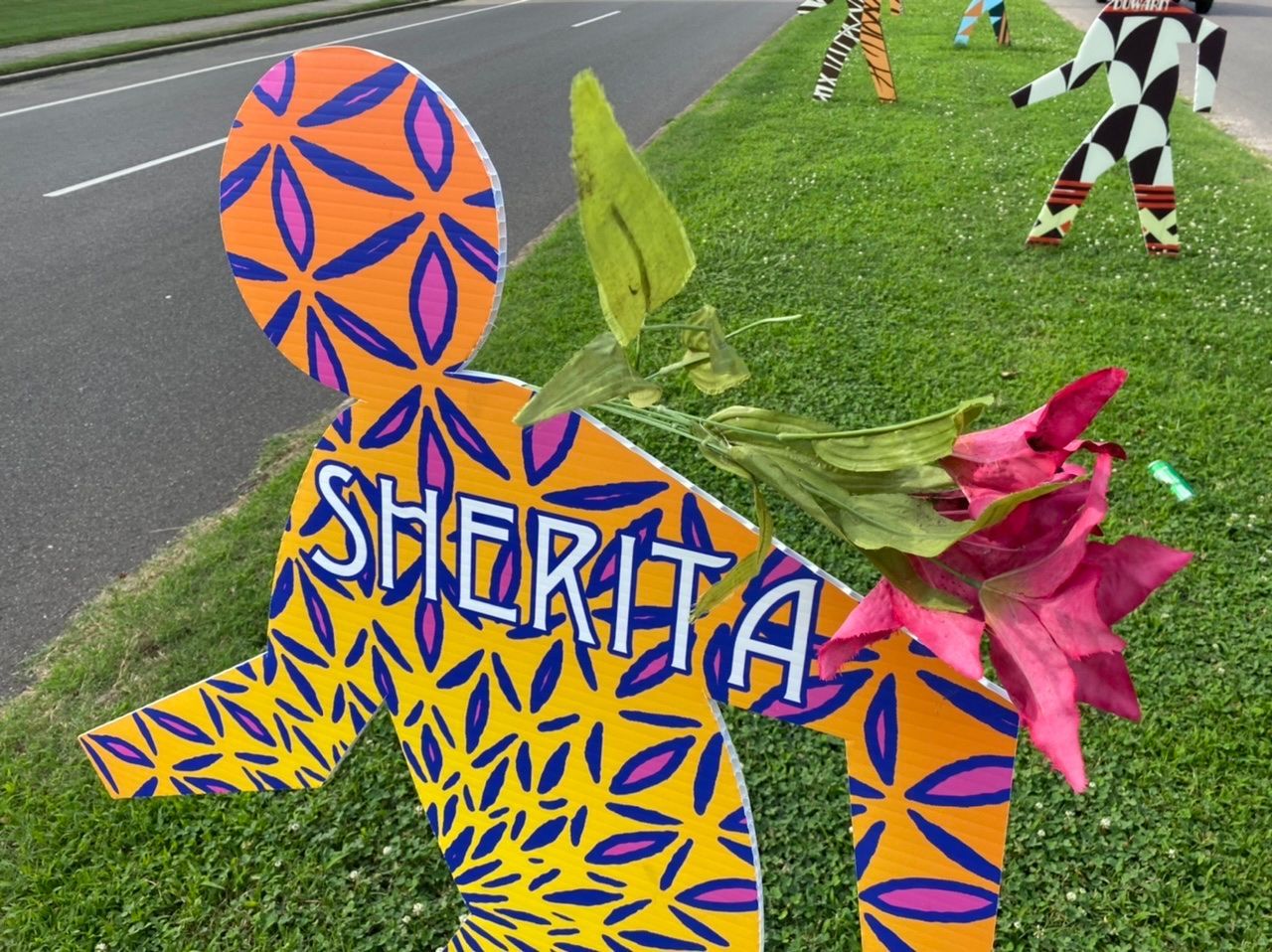Art Ministry, public ministry (am:pm)
memphis, tn
WE-Making is a suite of resources that explores the relationship between place-based arts practices and social cohesion as a means to advance health equity and community wellbeing. This We-Making story is one example of how place-based arts and cultural strategies uniquely contributed to social cohesion and wellbeing in this community. Throughout this story you’ll see terms paired with actions in parentheses (e.g., social capital, collective action, place attachment, civic engagement, self-determination of shared values). This is to denote for the reader how the WE-Making framework was specifically incorporated. Explore the WE-Making framework and resources.
Image credit: Art Ministry, Public Ministry
A line of human figures, plastic cutouts each resembling the walking symbol found on a city crosswalk sign, lies the tree-shaded median of National Street, an avenue known for excessive speeding and several recent pedestrian casualties. The figures stretch four city blocks, far enough that one can’t see one end of the line from the other. National Street cuts through the racially diverse and predominantly low income Heights neighborhood of Memphis. The figures stand in mid stride, ready to cross. An onlooker does a double take, seeing momentarily a huge crowd of people, real and living. Each figure is adorned with lively color, a unique pattern, and a name.
There is much in a name. It is one thing to say that 69 Memphians were killed while walking on our streets in 2020. It is far more impactful though to say that Audwin, Maliss, George and Anterious, and others, lost their lives. To walk among the figures, reading each name, appreciating each unique design – perhaps someone familiar to you comes to mind – this is an experience more powerful than numbers. Such an encounter is what the traveling sculpture installation Naming by artist Colin Kidder of Art Ministry, Public Ministry (AM:PM) seeks to create. By giving name and character to each of these individuals, it aims to make us see not just what the problem is, but the people hurt by it (mindset- orientation toward the common good).
2020 was a record year for traffic violence in our country. The number of pedestrians killed in traffic collisions in Memphis nearly doubled that of the previous year, with the trend continuing into 2021.
Naming invites viewers to consider the challenges that pedestrians encounter daily, such as blocked sidewalks, dangerous driving, and broken infrastructure (self determination of shared values- aligning with community change goals for equitable well-being). Statistics show that these hazards are disproportionately experienced by people of color and by the poor (civic capacity for structural and policy change- promoting creative efforts to protects safe public spaces).

One day, a silk flower appears on the head of Sherita, an anonymous contribution. This action, although small, is a symbol of community (collective action). On a humid July evening, a group of residents gathers amid the figures for a candlelight vigil organized by the Heights Community Development Corporation (social capital- bonding). A young girl reads all 69 names aloud.
Naming has been on exhibit in four locations around the city of Memphis, with attention given to areas of high pedestrian risk and neighborhoods of color. The Heights CDC originally commissioned Naming for their neighborhood. The grounds of the Frayser Community Development Corporation, a predominantly black neighborhood, was its next stop (creative responses to racism). From there it moved to Martin Luther King Jr. High School, also in Frayser. Its most recent location was next to a problematic downtown crosswalk heavily used by University of Tennessee medical students .
A number of observations were echoed by different people at each location, and these showed how Naming moved the dial of social change. Neighborhood residents and business owners alike remarked that while the installation was up, the speed of traffic slowed. For the month that the sculpture stood on National Street, no pedestrian accidents were reported. The day after it was moved, a pedestrian was hit. In addition to the remarkable traffic changes, there was immediate verbal engagement in the community. People stopped on the sidewalk, leaned out of car windows, and inquired in the shops, all asking what the figures represent (social capital- bridging, relationships and sense of belonging).
Artist Colin Kidder is director of AM:PM Studio, a non profit art organization serving the Heights neighborhood of Memphis. AM:PM creates art that is available to anyone at any time, with the goal to remove all real or perceived barriers to the enjoyment and benefit of art (civic engagement - willingness to participate, hyper-local). Our community building focus is in four main areas: a public work space with tool access and assistance, a community gallery with regular art shows, an outdoor art program, and an online presence for video documentation of projects and the sharing of our work with a larger community (collective efficacy- community ownership, celebration and preservation of culture).
It is our hope that Naming will bring awareness to the surging number of pedestrian deaths, as well as put a human face and a name on the problems it highlights. We want to engage community members in neighborhood power as well as pride, and give us the momentum to keep these positive changes going (mindset- orientation toward the common good). In moving individuals through this powerful sculpture, we feel that we can act and plan for a future where human life is more valued and better protected.






